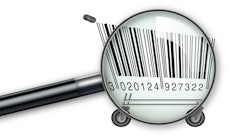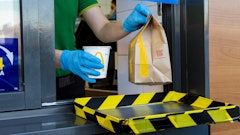Can consumer packaged goods manufacturers extract a return--on--investment from implementing Electronic Product Code tags at the case and pallet level?
The answer to that question will help determine the level of efficiency in the supply chain in the future. The EPC is an electronically coded tag that uses radio frequency identification (RFID) to provide real--time, automatic tracking of goods in the supply chain.
"We believe the EPC will enable the re--engineering of the supply chain, creating multiple benefits in efficiency, cost savings, improved customer service and greater product availability," says Dick Cantwell, vice president of The Gillette Co., Boston.
The stakes are high for CPG manufacturers. Wal--Mart Stores has been joined by Target, Albertsons, Tesco, Metro Group and a handful of other retailers, as well as the U.S. Department of Defense, in mandating that suppliers tag pallets and cases delivered to their distribution centers.
Just recently, EPCglobal US released the EPC Value Model. This report includes spreadsheet tools to allow CPG manufacturers to assess the value of implementing EPC technology based on their own business conditions. CVS, Metro Group and Wal--Mart Stores helped develop the report, along with Gillette, Johnson & Johnson, Kimberly--Clark and others. The report is seen as a milestone in the rollout of EPC tags.
"This is a foundational step for the EPC global community in understanding how value is derived from RFID implementation," says Mike Meranda, president of EPCglobal Inc., Lawrenceville, NJ. "It is the first widely available tool where a company can identify its own hot spots for RFID value."
EPCglobal is a joint venture between GS1 (formerly EAN International) and the Uniform Code Council (UCC). The not--for--profit organization aims to establish and support the EPCglobal Network as the global standard for real--time, automatic identification of information in the supply chain of any company, anywhere in the world.
According to Meranda, the model allows a company to input its own data. Then, the model helps project and quantify where value will be derived for an individual company. Those that have already implemented EPC can find out if gaining more value is possible.
"The importance of the release is that it lets everyone agree, or agree to disagree, about what is the starting point for doing an evaluation. It lets companies talk more openly about where EPC or RFID makes economic sense today and where it doesn’t," says Chris Clauss, Worldwide Auto I.D. Leader for IBM, Armonk, NY.
Standards Still An Issue
Widespread tagging of cases and pallets brings up two issues, according to Clauss. One deals with hardware and the other with software. With the former, it's making tags and readers cheaper and inter--operable. It's also making sure there are good levels of "read" reliability. With the latter, the issue is how many vendors are going to develop appropriate software. Will they adhere to standards for inter--operability?
"For CPG manufactures, the primary challenge to implementing at the case and pallet level is making sure that the EPC data is captured in the appropriate business context to ensure that the company can derive ROI from tracking goods movement and inventory across the supply chain," says Jon Karlen, director of product marketing at Oat Systems, a Waltham, MA--based pioneer in RFID software.
"Most CPG companies will find the initial payback on investment in RFID by taking advantage of the RFID data shared by the retailer," he adds. "But business context is required to turn the EPC data into valuable business information. For example, if the CPG company wants to improve promotions execution and ensure that promotional items reach the sales floor on the day of the launch and in compliance with the plan, the company will need to make sure that it links the promotional code to the correct items as it ships to the retailer. Then the company can track these products to the sales floor. That is an example of the business context required to drive ROI in RFID."
Meanwhile, several companies with long histories of RFID involvement have already made progress. Some have already applied the model to their businesses and see the value.
"By using this tool, a lot of companies will be able to accurately see how they can save money—and how much money they can save—by adopting RFID technology," says Dayna Fried, an RFID spokesperson for Hewlett--Packard, Palo Alto, CA, which is pleased with the early results that the model is providing.
Paul Fox, a spokesperson for Gillette, says, "The model is an analytical tool that can be applied on a systematic and continuous way for the various processes that you find in the supply chain. It allows us to absolutely quantify what the business benefits are to us as a manufacturer. With the aid of the value tool, we’ve been able to demonstrate that we can generate a 25 percent improvement in efficiencies per distribution center. That in itself is a significant value."
He also believes that companies not currently deploying EPC technology will also learn something. "It allows them to take this robust tool and apply it to their own businesses and quantify the results. So rather than being subjective, it becomes objective."
The experiences of HP and Gillette provide optimism to other companies that hope to benefit from this emerging technology. So what will it take for the industry to make a quantum leap forward on RFID?
"I think it would be if retailers figured out how to share visibility with their suppliers in a common way," concludes Clauss of IBM. "If the retailers can all agree on how that data will come back to the manufacturers, I think that's where the leap is."
According to Clauss, the potential for an ROI is clearly bigger for the retailer than it is for the manufacturer. That's because the manufacturer has the recurring cost of buying tags. If the retailer is going to put the cost of buying the tags onto the manufacturers, he points out, the retailers should give something in exchange.
"Some retailers are willing to share [data and visibility]," he explains. "To a degree, Wal--Mart, Target and Albertsons are all public and are all sharing with their vendors. They’re just choosing to share in different ways."
Long Term Success
Karlen of Oat Systems adds that the key for CPG companies is to take competitive advantage of the RFID data shared by retailers. To do this, it is critical that the company take "an incomplete, error--laden and noisy data set and infer from it the actual movement of goods in the physical world."
From this clean view of goods movement and inventory, the company can:
There is some disagreement over the timeline for widespread deployment of ECP technology. Most prognosticators agree that high--value goods and luxury products would be item tagged first, followed soon thereafter by CPG items, but there is some question about the pace of change.
"I view success as being very long term," says Clauss of IBM. "The best analogy for how long it will take is the barcode. It really took 25 years for the barcode to become completely pervasive. I’m not saying that RFID will take 25 years to mature, but it won’t mature in five years. I think we all need to go into this with our eyes wide open about a long adoption curve. There is going to be a gradual diffusion of the technology over a decade at least. It will gradually seep its way into more and more of the supply chain."
Fox of Gillette predicts that EPC tagging will be adopted widely at the pallet and case level over the next three to five years. In terms of item tagging, he sees two constraints:
"Realistically, we do see item level tagging occurring, but probably not for another eight to 10 years, by which stage volume in terms of the use of EPC tags will increase, and therefore we'll see a reduction in the unit cost of the tag," he says.
Meanwhile, Karlen of Oat Systems enthuses about "tremendous progress" being made. The firm developed a Pathway to ROI for Consumer Products that outlines initial ROI opportunities for CPG companies based on work with the industry’s early adopters. Initial applications include electronic proof--of--delivery solutions to reduce deductions; promotions executions and new product introductions. The company provides the RFID framework for Gillette, Kimberly--Clark, HP, Johnson & Johnson, Kodak, Sherwin Williams and others, and for half the retailers that have issued RFID mandates.
"Given the pace of new retailer initiatives, the tipping point is likely to occur in early 2006," he says. "We are already working with our most innovative CPG companies to roll out RFID deployments to multiple sites and upstream to manufacturing plants."
EPC vs. RFID
What is EPC?
What is RFID?


























